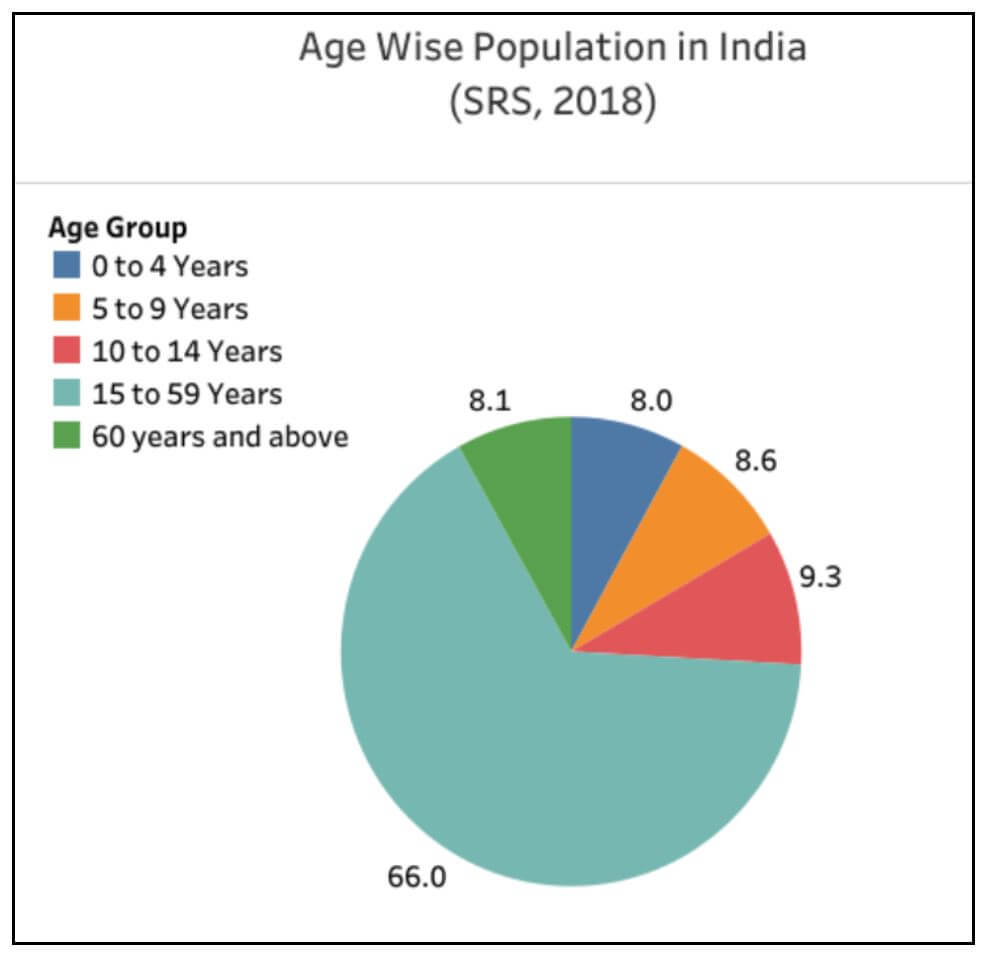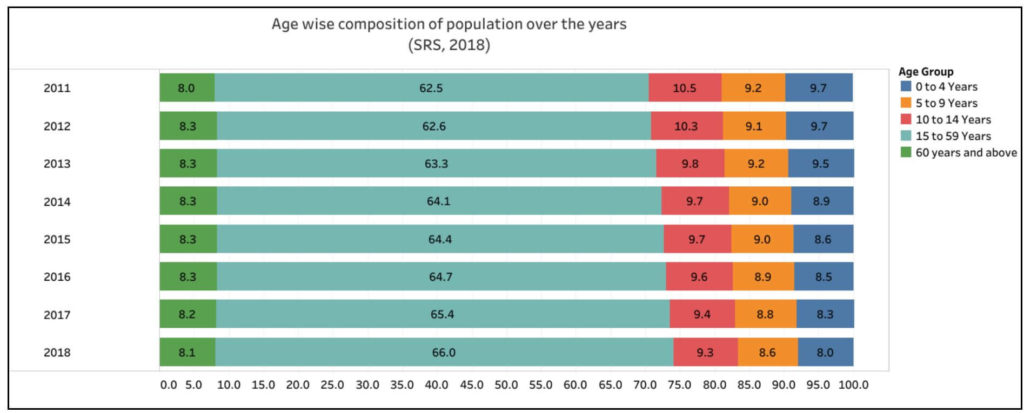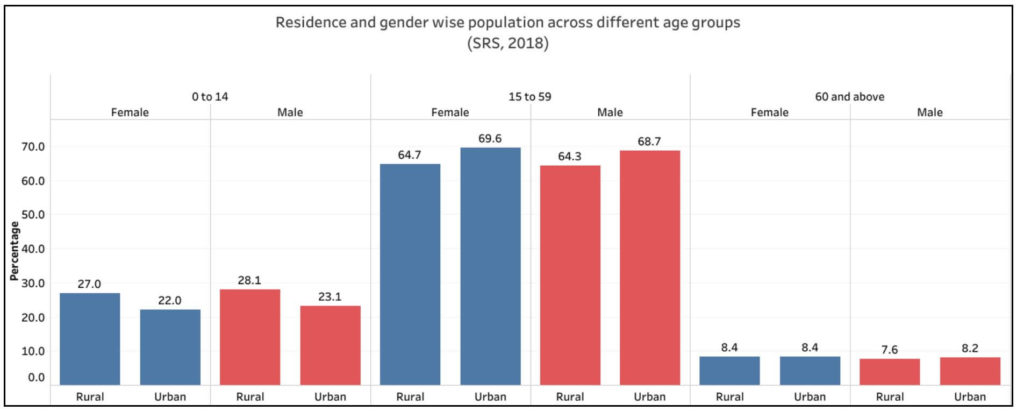As per the SRS 2018 data, about 25.9% of India’s population is in the 0-14 age group. However, this share in the southern states is much lower in the southern states and ranges from 19.8% to 23%. At an All-India level, the share of working age population (15-59 years) has increased in the last few years while the share of elderly has dropped slightly compared to 2016.
July 11 is adopted as World Population Day by the United Nations Development Programme (UNDP) in 1989 to bring attention, urgency and importance to population related issues. This year, the United Nations Population Fund, which is the world’s largest multilateral source of funding for population and reproductive health programs has decided to raise awareness about the sexual and reproductive health needs and vulnerabilities of women & girls during the pandemic. This is to safeguard the hard-fought gains and ensure that sexual & reproductive health rights stay on the local agenda, and to explore how to maintain the momentum towards achieving the SDGs by 2030.
Against the backdrop of world population day, this story takes a look at the population composition in India, the second most populous country in the world, as reported in the recently released annual Sample Registration System survey 2018. Age is one of the vital demographic characteristics, which is useful for the government to formulate policies or to plan developmental and health programs.
Since India gained independence, there has been considerable improvement in its health parameters such as life expectancy, healthcare facilities and education, and drop in fertility and mortality rates, which have contributed by and large to the demographic changes witnessed since then. Since 1971, proportion of India’s population under the age of 14 years has declined from 41.2% to 25.9% in 2018. Simultaneously, the proportion of elderly population, aged 60 years and above has increased from 5.3% to 8.1%.
About two thirds of India’s population belong to the working age group
As per the 2018 SRS survey results, 8% of the population were infants aged up to 4 years old, 8.6% were aged between 5 to 9 years, and 9.3% were aged between 10 to 14 years, at the national level. More than 34% of Bihar’s population constituted of children up to 14 years of age while Andhra Pradesh had reported only 19.8%. It can be seen that the total fertility rate of Bihar was the highest and that of Andhra Pradesh was among the lowest, which could be the reason for the huge difference in the share of under-15 age group.
India’s working population aged between 15 to 59 years constituted 66% of total population of the country. In contrast to the population composition of children (under 14) in the respective states, the states of Andhra Pradesh and Telangana have reported more than 70% of population falling in the working category as against Bihar, which reported the least, less than 60% of the population in the working category. A total of 8.1% of the India’s population were aged above 60 years, ranging from 6.3% in Bihar to close to 13% in Kerala.

Slight drop in the share of elderly population compared to 2016
The share of elderly population (60 years & above) has gradually increased since 1971. However, data from the past eight years indicates that the percentage of elderly persons in the population increased from 8% in 2011 to 8.3% in 2012 and stayed consistent till 2016. Compared to 2016, it has slightly decreased to 8.1% in SRS 2018.

Meanwhile, the share of those of those aged between 0 to 14 years has dropped significantly, from 29.4% in 2011 to 25.9% in 2018. The working population (15 to 59 years) has increased from 62.5% in 2011 to 66% in these eight years.
Southern states have lower share of population in the 0-14 age group
State-wise data indicates that the share of population in the 0 to 14 years is lower in southern states compared to the rest of the country. In fact, the number has been decreasing for the past few years. Southern states reported a higher share of persons in the working age and senior citizens categories. For instance, in 2018, the share of population in the 0-14 age group in southern states was between 19.8% in Andhra Pradesh and 23% in Karnataka. The highest such share in Karnataka (23%) is still lower than the national average of 25.9%. At the same time, national average share of persons above 60 years of age was 8.1% while the southern states reported between 8.1% to 12.9% in that age group. Similarly, in the case of working age group, India reported 66% while southern states reported between 68.6% to 71.1%, except Karnataka.
Share of Females more than Male counterparts in working age and elderly categories
In 2018, a total of 64.7% of females in rural areas and 69.6% of females in urban areas fell in the working age category of 15 to 59 years. This was higher than that of their male counterparts- 64.3% in rural areas, and 68.7% in urban areas. Among the elderly population, the percentage of female population stood at 8.4% in both rural and urban areas, higher than that of male population, which was 7.6% in rural and 8.2% in urban areas.
However, in case of children under 15 years of age, it was observed that proportion of females was lesser than that males by around 1%. In rural areas, the share of female population in this age group was reported as 27% whereas in urban areas, the percentage was lower at 22%. The sex ratio at birth i.e. number of females per 1000 males, is lower in urban areas as compared to rural areas since 2012. Between 2016-18, the child sex ratio at birth was 900 in rural areas and 897 in urban areas. The percentage of male population falling in this category stood at 28.1% in rural areas and 23.1% in urban areas.
A greater share of persons in the working age group are in Urban areas than in Rural areas
The data also indicated that the proportion of persons in urban areas was higher than that in rural areas in case of persons in the working age and senior citizens. At the same time, there were more children (under-15) in rural areas, than in urban areas. This may be the result of lower fertility rate in urban areas compared to rural areas.
Also, the proportion of women was more in the working age group and elderly category as against the proportion of men. Urban areas accounted for a greater share of persons than rural areas in these two categories. One reason for this might be the migration of rural population to urban areas seeking better opportunities in the working age group.

Migration to Southern states may continue
Prime Minister Narendra Modi had indicated that population explosion may pose challenges to the future generations during his Independence Day speech in 2019. However, if the current trends continue, the proportion of persons in the working age will decrease and the proportion of elderly persons will increase in the long run as health facilities and life expectancy improves. Furthermore, inter region disparities can also lead to increased influx of migrants into the southern states. For instance, Bihar which has a higher share of children now will have more persons in the working population in the coming 20 to 30 years, unlike in the southern states.
Featured Image: India’s population



1 Comment
Pingback: Southern States have lower population share in the 0-14 age group - RIGHTLIVING HEALTH BLOG